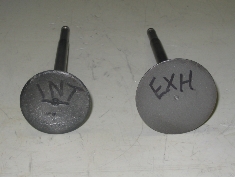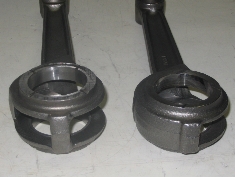Joe's Flathead
When you decide to hop up an antique engine you invariably wind up dealing with more complications than if you were doing similar modifications on a newer engine. Sometimes those complications are fairly easy to remedy">
|
|
|
|
Joe's Flathead When you decide to hop up an antique engine you invariably wind up dealing with more complications than if you were doing similar modifications on a newer engine. Sometimes those complications are fairly easy to remedy, but sometimes budget restraints lead you to compromises. Such was the case with Joe's motor. As we opened it up we found some things that were not expected, and many of them were doubtless the result of compromises made by a previous owner. We can't fault that previous owner for these compromises , because we don't know why he may have made the decisions that he did. Parts availability at that time is just one of the things that may have been a factor. The first obvious thing we found was that the motor had oversize valves and had been ported and relieved. At first glance this appeared to be a plus, but a closer look revealed that it would have been better if the ports had been untouched. First of all, while one of the valves was a generous oversize, it was the wrong valve. The exhaust was considerably larger than the intake, and the relieving was deeper on the exhaust side than the intake. The exhaust valve being larger than the intake could be explained by a badly damaged seat at some point in time, but this doesn't account for the relieving on the exhaust side being deeper than on the intake. Such a combination would seem to suggest plans to use a turbocharger at some point in time, but that is pure speculation on my part.
The next problem that was apparent was that the right case race had a series of 4 short welds around its outer diameter. Evidently someone had reason to believe that it would come loose without this modification. My first instinct was that if the race could be lapped to straight and round while maintaining acceptable clearances, that it would be best to leave well enough alone. After considerable "soul searching" I decided that it really needed to be addressed. One last item that I noticed right off, but really didn't get my attention as it should have, was the fact that this motor had the pre 1940 open female rod instead of the updated one that you would expect to find in a '44 model. I say that it didn't get my attention as it should have because, while I noticed that it was an open female rod which is prone to cracking, I did not realize that it was from a earlier year. Over the years, every time I have had occasion to rebuild a set of open rods, I have first had them magnafluxed. Each time they have proven to have cracks in the webbing at the bottom of the rod. This set was no different .
Much less apparent was the fact the female rod was narrower than a big twin rod. I assume this is due to the sides of the female rod having been ground at some point, rather than it being designed that way. If your rods have been ground to make them narrower, it would only be to increase the end play of the rods. If you need to increase the end play it is usually due to one of two problems; a mis-machined crankpin (too short) or flywheel tapers that are too deep (over tightened?). Either way, it becomes a problem when building a stroker, because both the flywheels and crankpin will be replaced, giving you excess end play. In our case we would have wound up with about .090" rod end play. About now you may be saying to yourself "what a mess". And a mess it is; but the question is how do we fix it? If Joe was independently wealthy, we could have simply ordered new cylinders from Flathead Power, a new set of aftermarket connecting rods and maybe even looked for a good used right case half. But here is where the inevitable compromises come in. The trick is to make the compromises needed to keep the project financially feasible without compromising the integrity of the engine. In the pages to follow, I will attempt to document how we (hopefully) accomplished this.
|
|
|
 Stock (1.940) intake valve on left, oversize (2.164") exhaust valve on right.
Stock (1.940) intake valve on left, oversize (2.164") exhaust valve on right.  Open early Flathead rod on left, closed (XL) rod shown on right for comparison.
Open early Flathead rod on left, closed (XL) rod shown on right for comparison.